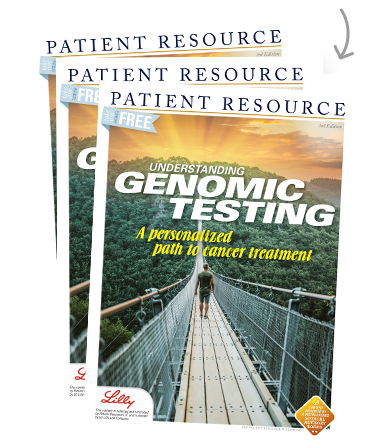Understanding the Genomics and Genetics of Cancer
Along with the many blood tests, imaging scans, surgical removal of tumors, and/or tumor biopsies that will be performed to diagnose your cancer, stage it and follow its response to treatment, genomic tests may be ordered to identify any biomarkers or mutations that are present in your cancer. Your doctor will review the test results after a pathologist (a doctor specially trained to diagnose disease by looking at cells under a microscope) and/or a molecular pathologist have examined a sample. The results will help your medical team determine whether therapies that are approved for any found mutations should be included in your treatment plan.
During the diagnostic process, your doctor will discuss the possibility of genomic testing with you. It may not be necessary or beneficial for all patients to have genomic testing, but it should be routine in all younger patients, especially if they have a no-smoking or light-smoking history. It is also recommended for patients with advanced or metastatic cancer. If your doctor has not talked with you about the testing, ask whether it is appropriate for you.
The type of test and the sample used for testing will vary, depending on the cancer involved and the information your doctor is seeking.
Results from diagnostic testing may not detect a biomarker or mutation or may discover one that does not yet have an approved treatment. If you are in either of those situations, do not be alarmed. You still have options, such as the current standard of care treatment for your specific diagnosis or a clinical trial. Your doctor will talk with you about all potential therapies as you discuss your treatment plan.

You may have genomic testing at other times during your care. Your doctor may use it if cancer returns or progresses, to determine whether the cancer is responding or to monitor for a recurrence.
About The Testing Process
In many cases, using a biopsy sample is crucial to diagnosing the type of cancer you have because it will help your doctor determine the most effective type of treatment. In general, your doctor will follow these steps.
1. A biopsy of tumor tissue is taken. It can be done by several methods, and different tests require different amounts of tissue. Ask your doctor how your testing will be done before the biopsy to make sure enough tissue samples will be taken to meet the requirements of all the necessary tests.
2. The sample is sent to a laboratory where a pathologist will look for the presence of cancer cells and document certain characteristics of the tumor cells in the sample.
3. If cancer cells are found, they will be extracted from the sample so the pathologist can determine the histologic type of the cancer. The six major histologic types are carcinoma, sarcoma, myeloma, leukemia, lymphoma and mixed types. In some instances, the pathologist may not be able to identify the histologic type because the tissue sample is too small. When this happens, another biopsy may be necessary.
4. Specialized equipment will be used to sequence the tumor’s DNA and find any abnormalities. DNA sequencing determines the order of the four building blocks – referred to as “bases” – that make up the DNA molecule.
5. If abnormalities are found, they will be compared to known mutations of the type or subtype of your particular cancer.
6. Results are returned to your doctor in a pathology report (see Your Pathology Report, page 12).
7. If a known abnormality is found, your doctor may suggest treatment options that are approved to target the same mutations.
8. If a mutation is found that does not have a specialized treatment, your doctor may recommend standard of care treatment. It is also possible that a clinical trial that is testing the mutation identified in your tissue sample is underway. Ask your doctor whether that may be an option to consider.
9. Genomic testing may be repeated during follow-up appointments to monitor the effectiveness of your current treatment, or if your doctor suspects a recurrence or resistance because sometimes new mutations can develop.



